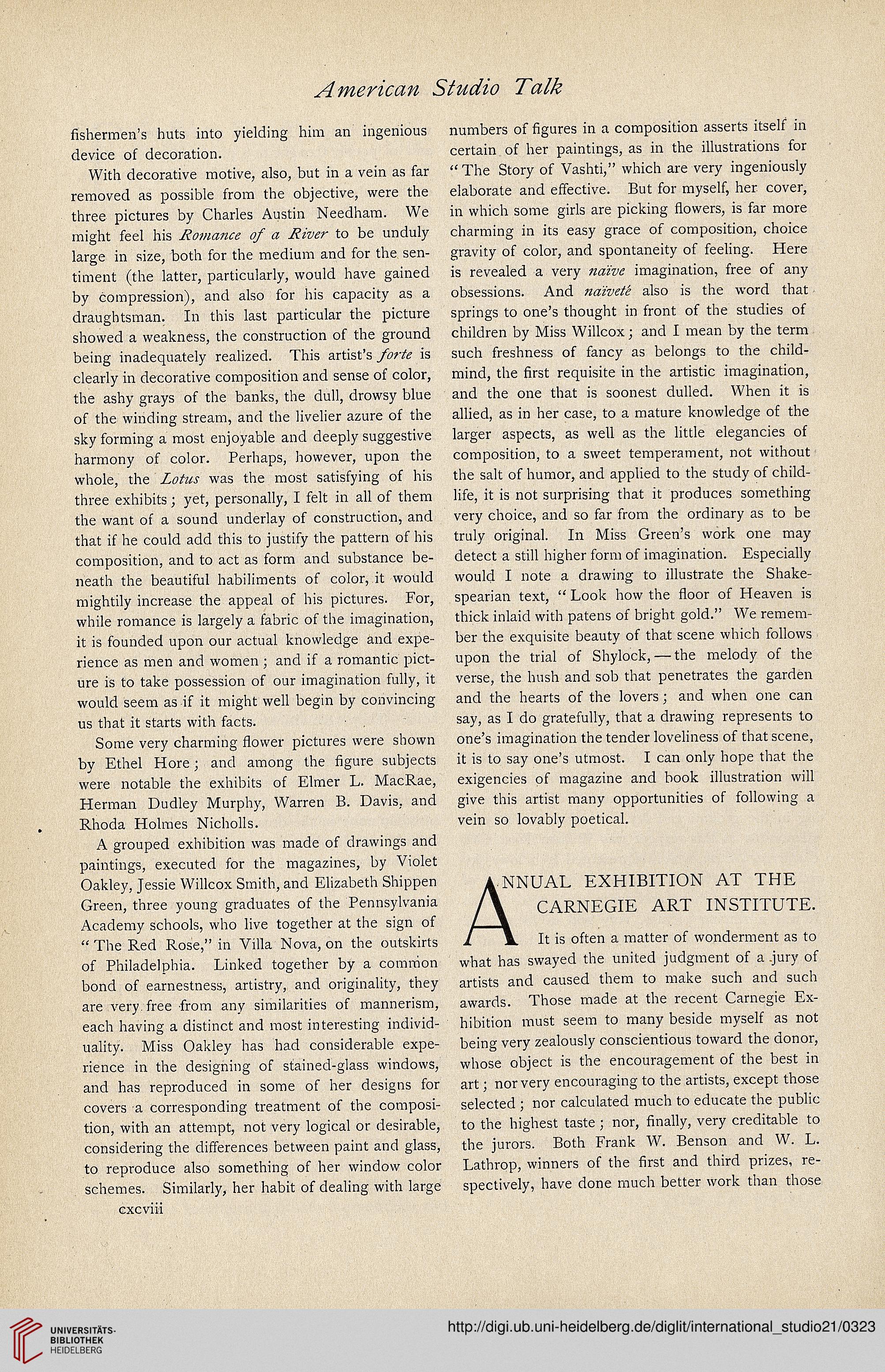fishermen'shutsintoyieidinghimaningenious
deviceofdecoration.
With decorative motive, also, but in a vein as far
removed as possibie from the objective, were the
three pictures by Charles Austin Needharn. We
might feei his a Wz'^T* to be unduly
iarge in size, both for the mediunr and for the sen-
timent (the iatter, particuiariy, wouid have gained
by compression), and aiso for his capacity as a
draughtsman. In this last particuiar the picture
showed a weakness, the construction of the ground
being inadequately reaiized. This artist's yivA? is
ciearly in decorative composition and sense of coior,
the ashy grays of the banks, the duii, drowsy biue
of the winding streanr, atni the iiveiier azure of the
sky forming a most enjoyabie and deepiy suggestive
harnrony of coior. Perhaps, however, upon the
whoie, the was the most satisfying of his
three exhibits; yet, personaiiy, I feit in ali of thern
the want of a sound underiay of construction, and
that if he couid add this to justify the pattem of his
composition, and to act as form and substance be-
neath the beautifui habiiiments of coior, it wouid
mightiiy increase the appeai of his pictures. For,
whiie romance is iargeiy a fabric of the imagination,
it is founded upon our actuai knowiedge and expe-
rience as men and women ; and if a romantic pict-
ure is to take possession of our imagination fuiiy, it
wouid seem as if it might weil begin by convincing
us that it Starts with facts.
Sorne very charming Hotver pictures were shown
by Ethei Höre; and among the Hgure subjects
were notabie the exhibits of Eimer L. MacRae,
Herman Dudiey Murphy, Warren B. Davis, and
Rhoda Hoimes Nichoiis.
A grouped exhibition was rnade of drawings and
paintings, executed for the magazines, by Vioiet
Oakiey, Jessie Wiiicox Smith, and Eiizabeth Shippen
Green, three young graduates of the Pennsyivania
Academy schoois, who iive together at the sign of
"The Red Rose," in Yiiia Nova, on the outskirts
of Phiiadeiphia. Linked together by a common
bond of earnestness, artistry, and originaiity, they
are very free from any similarities of mannerism,
eachhavingadistinct and most interestingindivid-
uaiity. Miss Oakiey has had considerabie expe-
rience in the designing of stained-glass Windows,
and has reproduced in sorne of her designs for
covers a corresponding treatnrent of the composi-
tion, with an attempt, not very iogicai or desirabie,
considering the differences between paint and giass,
to reproduce also something of her window coior
schemes. Simiiariy, her habit of deaiing with large
cxcviii
numbers of figures in a composition asserts itseif in
certain of her paintings, as in the iiiustrations for
"The Story of Vashti," which are very ingeniousiy
eiaborate and effective. But for rnyseif, her cover,
in which sorne giris are picking fiowers, is far more
charming in its easy grace of composition, choice
gravity of coior, and spontaneity of feeiing. Here
is reveaied a very 7Mz'sy<? imagination, free of any
obsessions. And 7Mw/<* aiso is the word that
springs to one's thought in front of the studies of
chiidren by Miss Wiiicox; and I rnean by the term
such freshness of fancy as beiongs to the chiid-
rnind, the first requisite in the artistic imagination,
and the one that is soonest dulied. When it is
aiiied, as in her case, to a mature knowiedge of the
iarger aspects, as weii as the iittie eiegancies of
composition, to a sweet temperanrent, not without
the sait of humor, and applied to the study of chiid-
iife, it is not surprising that it produces something
very choice, and so far from the ordinary as to be
truiy origina). In Miss Green's work one may
detect a still higher form of imagination. Especiaiiy
wouid I note a drawing to iiiustrate the Shake-
spearian text, " Look how the Hoor of Heaven is
thick iniaid with patens of bright goid." We remem-
ber the exquisite beauty of that scene which foiiows
upon the triai of Shyiock, — the meiody of the
verse, the hush and sob that penetrates the garden
and the hearts of the iovers; and when one can
say, as I do gratefuily, that a drawing represents to
one's imagination the tender ioveiiness of that scene,
itis to say one's utmost. I can oniyhope that the
exigencies of magazine and book iiiustration wiii
give this artist many opportunities of foiiowing a
vein so iovably poeticai.
^NNUAL EXHIBITION AT THE
/\ CARNEGIE ART INSTITUTE.
7 It is often a matter of wonderment as to
what has swayed the United judgtnent of a .jury of
artists and caused them to make such and such
awards. Those made at the recent Carnegie Ex-
hibition must seem to many beside rnyseif as not
being very zealousiy conscientious toward the donor,
whose object is the encouragement of the best in
art; nor very encouraging to the artists, except those
seiected ; nor caicuiated much to educate the public
to the highest taste; nor, fmaiiy, very creditabie to
the jurors. Both Frank W. Benson and W. L.
Lathrop, winners of the hrst and third prizes, re-
spectiveiy, have done much better work than those




